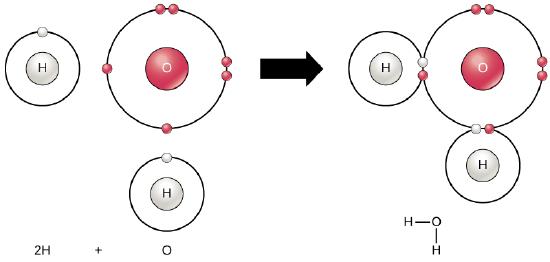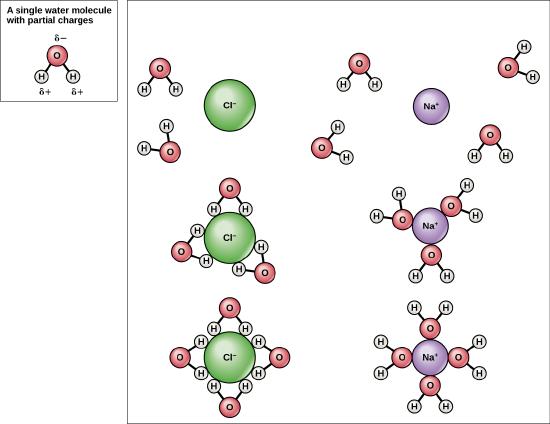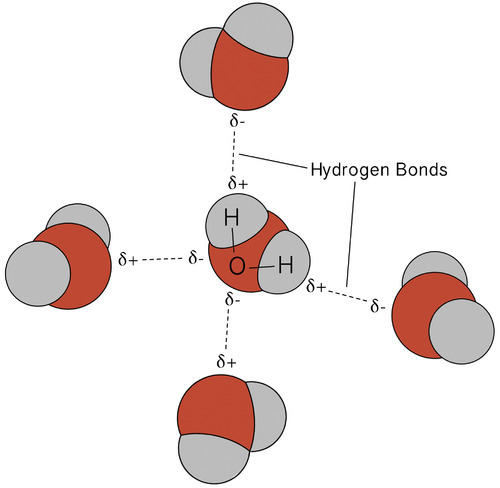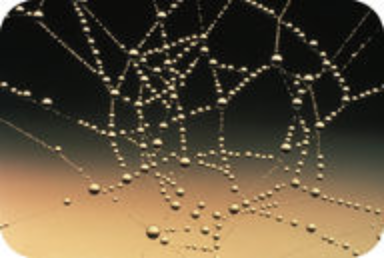Which Feature Or Property Of Water Allows Plants To Draw Liquid Water Up From Their Roots?
2.11: Biochemical Properties of Water
- Page ID
- 30616
It's often called the "h2o planet," and it's been given the nickname "the blueish marble." You lot probably merely call information technology "home." Almost 3-quarters of our habitation planet is covered by water, and without it, life as we know it could non exist on World. Water, like carbon, has a special part in living things. Information technology is needed by all known forms of life. Although water consists of simple molecules, each containing but three atoms, its structure gives it unique properties that assist explain why it is vital to all living organisms.

Chemic Construction and Properties of Water
You are probably already familiar with many of the water'southward properties. For instance, you no dubiousness know that water is tasteless, odorless, and transparent. In small quantities, it is also colorless. Still, when a large amount of water is observed, as in a lake or the ocean, it is actually calorie-free blue in colour. The blue hue of the water is an intrinsic property and is caused by selective absorption and scattering of white light. These and other properties of h2o depend on its chemical structure.
The transparency of water is important for organisms that live in water. Because h2o is transparent, sunlight can pass through information technology. Sunlight is needed by h2o plants and other water organisms for photosynthesis.
Chemic Structure of Water
Each molecule of water consists of one atom of oxygen and two atoms of hydrogen, so information technology has the chemical formula HiiO. The organization of atoms in a water molecule, shown in Figure \(\PageIndex{ii}\), explains many of the h2o's chemic backdrop. In each h2o molecule, the nucleus of the oxygen atom (with 8 positively charged protons) attracts electrons much more than strongly than exercise the hydrogen nuclei (with only one positively charged proton). This results in a negative electrical charge well-nigh the oxygen atom (due to the "pull" of the negatively charged electrons toward the oxygen nucleus) and a positive electric charge nearly the hydrogen atoms. A difference in electrical charge between unlike parts of a molecule is called polarity. A polar molecule is a molecule in which part of the molecule is positively charged and part of the molecule is negatively charged.

Water is a good solvent
Water is considered a very good solvent in the biochemical reactions. Effigy \(\PageIndex{iii}\) illustrates how water dissolves salts. Table salt (NaCl) consists of a positively charged sodium ion and a negatively charged chloride ion. The oxygen of water is attracted to the positive Na ion. The hydrogens of h2o are attracted to the negative Cl ion.

Hydrogen Bonding
Opposite electric charges concenter 1 another. Therefore, the positive role of one water molecule is attracted to the negative parts of other water molecules. Considering of this allure, bonds form between hydrogen and oxygen atoms of adjacent water molecules, equally demonstrated in Figure \(\PageIndex{4}\). This type of bail always involves a hydrogen atom, so it is called a hydrogen bond.
Hydrogen bonds tin likewise class within a unmarried large organic molecule. For example, hydrogen bonds that form between unlike parts of a poly peptide molecule bend the molecule into a distinctive shape, which is of import for the poly peptide'south functions. Hydrogen bonds also agree together the two nucleotide chains of a DNA molecule.

Sticky, Wet H2o
H2o has some unusual properties due to its hydrogen bonds. One belongings is cohesion, the tendency for water molecules to stick together. The cohesive forces between water molecules are responsible for the phenomenon known as surface tension. The molecules at the surface exercise not have other similar molecules on all sides of them and consequently, they cohere more strongly to those direct associated with them on the surface. For example, if you drop a tiny corporeality of water onto a very smooth surface, the h2o molecules will stick together and form a droplet, rather than spread out over the surface. The same thing happens when water slowly drips from a leaky faucet. The h2o doesn't autumn from the faucet as individual h2o molecules just as droplets of h2o. The trend of water to stick together in aerosol is also illustrated by the dew drops in Effigy \(\PageIndex{5}\).

Another important physical holding of h2o is adhesion. In terms of water, adhesion is the bonding of a water molecule to some other substance, such as the sides of a leaf's veins. This process happens because hydrogen bonds are special in that they pause and reform with cracking frequency. This abiding rearranging of hydrogen bonds allows a per centum of all the molecules in a given sample to bail to another substance. This grip-like characteristic that water molecules form causes capillary activity, the ability of a liquid to menstruation against gravity in a narrow space. An instance of capillary action is when y'all place a straw into a drinking glass of water. The water seems to climb up the straw before you even identify your oral cavity on the harbinger. The water has created hydrogen bonds with the surface of the straw, causing the h2o to adhere to the sides of the harbinger. As the hydrogen bonds keep interchanging with the straw's surface, the water molecules interchange positions and some begin to ascend the straw.
Adhesion and capillary activeness are necessary to the survival of most organisms. It is the mechanism that is responsible for water transport in plants through roots and stems, and in animals through modest blood vessels.
Hydrogen bonds also explain why h2o's humid betoken (100°C) is college than the humid points of similar substances without hydrogen bonds. Because of water's relatively loftier humid point, most water exists in a liquid country on Earth. Liquid water is needed past all living organisms. Therefore, the availability of liquid water enables life to survive over much of the planet.
Furthermore, water has a high specific estrus because it takes a lot of energy to enhance or lower the temperature of the water. Equally a result, h2o plays a very important function in temperature regulation. Since cells are made up of water, this property helps to maintain homeostasis.
The Density of Ice and Water
The melting betoken of h2o is 0°C. Below this temperature, water is a solid (ice). Unlike nigh chemical substances, water in a solid state has a lower density than water in a liquid state. This is because h2o expands when it freezes. Once more, hydrogen bonding is the reason. Hydrogen bonds crusade water molecules to line up less efficiently in water ice than in liquid water. As a effect, h2o molecules are spaced further apart in ice, giving water ice a lower density than liquid water. A substance with lower density floats on a substance with higher density. This explains why ice floats on liquid h2o, whereas many other solids sink to the lesser of liquid h2o.
In a large ocean, such as a lake or the body of water, the water with the greatest density always sinks to the bottom. Water is near dense at about 4°C. Every bit a outcome, the h2o at the lesser of a lake or the ocean ordinarily has a temperature of about 4°C. In climates with common cold winters, this layer of 4°C water insulates the bottom of a lake from freezing temperatures. Lake organisms such as fish can survive the winter by staying in this cold, but unfrozen, water at the lesser of the lake.
Review
- Describe the structure of a water molecule. What is polarity, and why is water polar?
- Explain how the internal polarity of the water molecule makes it a good solvent?
- Explain how hydrogen bonds cause molecules of liquid water to stick together.
- What is capillary activeness? Requite an example.
- What belongings of h2o helps to maintain homeostasis and how?
Explore More
Source: https://bio.libretexts.org/Courses/Community_College_of_Vermont/Human_Biology_%28Gabor_Gyurkovics%29/02:_Chemistry_of_Life/2.11:_Biochemical_Properties_of_Water
Posted by: crawfordthereque1967.blogspot.com



0 Response to "Which Feature Or Property Of Water Allows Plants To Draw Liquid Water Up From Their Roots?"
Post a Comment